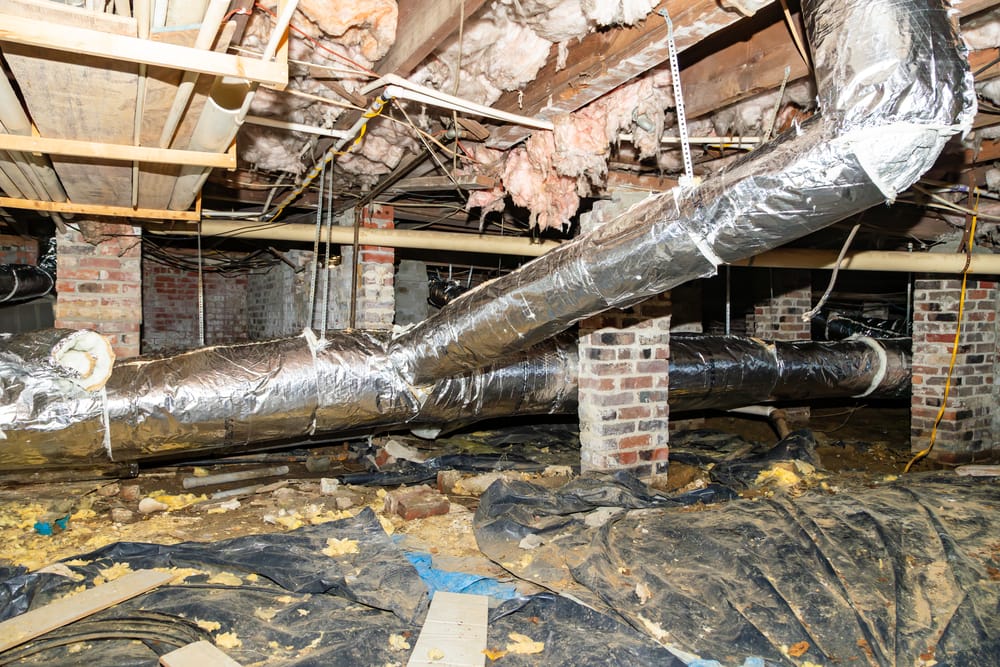I’ve seen it too many times to count. Homeowners, just like you, discover mold lurking in their crawl space. Panic sets in. Is my family’s health at risk? How do I get rid of this? Don’t worry, I’m here to guide you through the process of crawl space mold remediation.
Mold in your crawl space isn’t just unsightly; it can lead to serious health issues and structural damage. But with the right knowledge and action plan, you can take control of the situation and protect your home and loved ones.
Ready to tackle this problem head-on? Let’s dive in.
Signs of Mold in Your Crawl Space
Have you recently inspected your crawlspace? Chances are, it has been a long time. A lot of individuals are unfamiliar with what a crawl space is and its significance. The main role of a crawl space is to enhance air circulation within the house and provide convenient access for plumbing, electrical, maintenance, repair, and installation requirements. Upon discovering mold or detecting a musty odor in their crawl space, homeowners often become anxious.
Musty Odors
A musty smell in your crawl space is a sign of mold growth. If you notice a damp, earthy odor emanating from your crawl space, it’s time to investigate further. Don’t ignore the smell, as it could indicate a serious mold problem that needs immediate attention. Visible mold growth on wood surfaces, insulation, or other materials in the crawl space is a clear indication of a mold problem. Look for patches of black, green, or white fuzzy growth on floor joists, foundation walls, and other surfaces. If you spot any suspicious growth, it’s crucial to address it promptly to prevent the mold from spreading further.
High Humidity Levels
High humidity levels in a crawl space can lead to condensation on wood surfaces, creating an ideal environment for mold growth. If you notice condensation or moisture buildup in your crawl space, it’s a sign that the humidity levels are too high. Investing in a hygrometer to monitor the humidity levels can help you stay on top of any potential mold development.
Water Damage or Leaks
Water damage or leaks in the crawl space can provide the moisture needed for mold to develop and spread. Look for signs of water intrusion, such as water stains, peeling paint, or rotting wood. If you notice any water damage, it’s essential to identify and fix the source of the leak to prevent further mold growth.
Causes of Mold Growth in Crawl Spaces
A vented crawl space is the main reason for mold growth. Vented crawlspaces allow humid air to enter the crawl space and condensate on the wood surfaces, which then creates mold and wood-destroying fungus. High humidity levels, typically above 60%, can lead to moisture buildup and mold development in crawl spaces.
Water Leaks and Flooding
Extended saturation from water leaks or flooding can lead to other fungal growth, such as dry rot and brown rot, which can degrade the framing. This type of fungal growth requires much higher levels of moisture than mold. Plumbing leaks, foundation cracks, and poor drainage around the foundation can all contribute to water intrusion and mold growth in crawl spaces. Poor ventilation in a crawl space can trap moisture and create a breeding ground for mold spores. Without proper air circulation, the humidity levels in the crawl space can quickly rise, leading to condensation and mold growth. Adequate ventilation is crucial for maintaining a dry and healthy crawl space environment.
Lack of Vapor Barrier
Once the crawl space is sealed with a vapor barrier covering the earth and a proper vapor barrier on the foundation walls, you can install a dehumidifier to control the humidity and prevent mold growth. Without a vapor barrier, moisture from the soil can seep into the crawl space, increasing humidity levels and promoting mold development.
Health Risks Associated with Crawl Space Mold
Aspergillus, a common type of mold found both indoors and outdoors, can cause respiratory problems, especially for individuals with weakened immune systems who are likely to get sick from this mold. Exposure to mold spores can irritate the respiratory system, leading to coughing, wheezing, and difficulty breathing.
Allergic Reactions
Mold spores can trigger allergic reactions, such as itchy eyes and a stuffy nose, in sensitive individuals. Symptoms may include sneezing, runny nose, red and watery eyes, and skin rashes. Prolonged exposure to mold can exacerbate allergies and lead to more severe health issues.
Weakened Immune System
Mold exposure can weaken the immune system, making individuals more susceptible to other illnesses. People with compromised immune systems, such as the elderly, young children, and those with chronic health conditions, are at a higher risk of experiencing adverse health effects from mold exposure.
Steps to Remove Mold from Your Crawl Space
When you remove the mold and don’t fix the source, the mold will return. It is recommended that a crawl space be completely encapsulated so that you can control the temperature and humidity in the crawlspace. Identifying and addressing the moisture sources, such as plumbing leaks, foundation cracks, or poor drainage, is crucial for successful mold remediation.
Wear Protective Gear
When removing mold, it is essential to wear protective equipment to avoid exposure to mold spores. Proper protective gear includes a respirator with a HEPA filter, goggles, gloves, and protective clothing that covers your skin. Taking these precautions can help minimize the health risks associated with mold removal. Remove any contaminated materials, such as insulation or wood, that cannot be effectively cleaned. Porous materials that have been heavily contaminated with mold should be carefully removed and disposed of to prevent the mold from spreading further.
Clean and Disinfect Surfaces
Clean and disinfect all surfaces affected by mold using a safe mixture of biodegradable cleaning agents and a proprietary application method. Scrub the surfaces thoroughly to remove the mold and ensure that all areas are treated. Use a HEPA vacuum to remove any remaining mold spores and debris.
Dry the Area Thoroughly
After cleaning and disinfecting, ensure that the crawl space is thoroughly dried to prevent future mold growth. Use fans and dehumidifiers to remove excess moisture and maintain proper humidity levels in the crawl space. Adequate ventilation and air circulation are essential for keeping the area dry and mold-free.
Preventing Future Mold Growth in Your Crawl Space
Once the crawl space is sealed with a vapor barrier covering the earth and a proper vapor barrier on the foundation walls, you can install a dehumidifier to control the humidity and prevent mold growth. A vapor barrier helps prevent moisture from seeping into the crawl space from the soil, reducing humidity levels and minimizing the risk of mold development.
Improve Ventilation
Adequate ventilation in the crawl space can help regulate humidity levels and prevent mold development. Consider installing a crawl space ventilation system or using fans to promote air circulation. Proper ventilation helps remove excess moisture and keeps the crawl space dry and healthy. Ensure that the crawl space has proper drainage to prevent water accumulation and moisture issues. Install a sump pump to remove any standing water and direct water away from the foundation. Regularly inspect and maintain gutters and downspouts to ensure that water is diverted away from the crawl space.
Monitor Humidity Levels
Regularly monitor humidity levels in the crawl space and take steps to maintain proper levels to prevent mold growth. Use a hygrometer to measure the humidity levels and aim to keep them below 50%. If the humidity levels are consistently high, consider using a dehumidifier to remove excess moisture from the air.
Address Leaks Promptly
Promptly address any water leaks or plumbing issues to prevent moisture buildup and mold growth in the crawl space. Regularly inspect the crawl space for signs of water intrusion and fix any leaks or cracks in the foundation immediately. Addressing water issues promptly can help prevent mold from developing and spreading.
When to Hire a Professional Mold Remediation Company
If the mold growth in your crawl space is extensive or widespread, it is best to hire a professional mold remediation company to handle the removal process. Extensive mold growth can be difficult and dangerous to remove on your own, and professionals have the expertise and equipment necessary to safely and effectively remediate the mold.
Health Concerns
If you or your family members are experiencing health issues related to mold exposure, it is essential to hire professionals to ensure thorough and safe removal. Mold exposure can cause serious health problems, and attempting to remove the mold yourself can put you at risk of further exposure and potential health complications. Professional mold remediation companies have the equipment and expertise to access and treat hard-to-reach areas in your crawl space. Crawl spaces can be tight and difficult to navigate, and professionals have the tools and training necessary to safely and effectively remove mold from these challenging areas.
Lack of Proper Equipment
If you do not have the proper equipment or protective gear to safely remove mold, it is best to hire professionals who have the necessary tools and expertise. Attempting to remove mold without the proper equipment can be dangerous and may lead to the spread of mold spores throughout your home. Preventing mold is a cost-effective measure compared to addressing potential health issues in the future. Don’t take unnecessary risks. At Impact Crawlspace LLC, we conduct complimentary inspections and offer affordable solutions beyond your expectations. We specialize in mold remediation services for residential and commercial properties. Our approach goes beyond mere mold extermination; we strive to completely eradicate all mold varieties from your basement or crawl space and implement preventive measures. Utilizing eco-friendly cleaning products and our unique application technique, we ensure thorough service that sets us apart. Reach out for further details.
Checking your crawl space can reveal mold signs like musty odors, visible growth, and water damage. High humidity and poor ventilation are key culprits. Mold poses serious health risks, including respiratory issues and weakened immune systems. Remediation steps include fixing moisture sources, using protective gear during removal, cleaning thoroughly, and ensuring the area stays dry to prevent future growth. Don’t hesitate to hire professionals for extensive problems or if you lack proper equipment.
Conclusion
Crawl space mold remediation is no small task, but it’s a critical one for the health and safety of your home and family. By identifying the signs, addressing moisture sources, and following proper cleaning and prevention techniques, you can say goodbye to mold for good.
Remember, if the job seems too big to handle on your own, don’t hesitate to call in the professionals. They have the expertise and equipment to tackle even the toughest mold infestations.
Take action today to protect your home and loved ones from the dangers of crawl space mold. You’ve got this!

